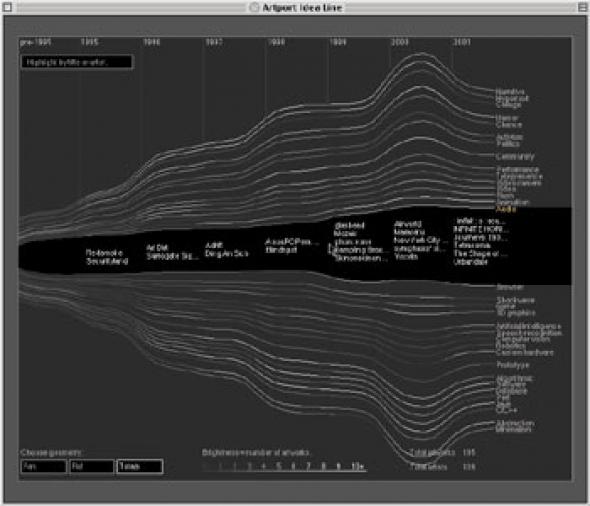Lines Drawn in the Sand of Time
Josephine Bosma reviews artist Martin Wattenberg’s latest work – a map interface for net art history
Art on the net is becoming a very broad field indeed. From the beginning, the variety of works and the overlap of disciplines within what we still call ‘net art’ have been striking. So definitions of net art that reduce it to the limitations set by technology alone fail. We might have to realise that art in general has simply found new space to develop in. But one reason to continue attaching the prefix ‘net’ to ‘art’ is the need for more focus on quite specific changes within the art realm which are occurring through the influence of new media technologies. Martin Wattenberg is one such artist, whose work focuses in detail on the materials through which mediated environments (and realities) are constructed.
Much of Martin Wattenberg’s work has a sensitivity of form which is quite refreshing. His work, like handwriting, has an unusually personal style. Trembling lines, fragile moving floating forms, unexpected perspectives, not only reveal Wattenberg’s sensitivity to the nature of online representation but also invite us to project our own reality on top. In his latest work Idea Line, a map interface for net art, one can respond to this invitation both philosophically and literally. The ability to create both mind space and access space for what is often so disrespectfully called ‘the user’ seems to be Wattenberg’s focus.
Idea Line bears a remote resemblance to an interface called Starry Night that he designed with Alex Galloway for Rhizome and which, comparably, avoids any critical reflection on the data it holds. But unlike its predecessor, Idea Line is quite easily accessible and searchable. Wattenberg, however, insists that his work does include a strong critical component: ‘One of the crucial aspects of much of my work is that I want to make people question the interfaces they see every day.’ So the absence of, say, an editorial hand in the arrangement of data could be interpreted as a critique of other editorial or thematic treatments of the same data.
The ‘idea line’ itself is not one line but several; it forms a fan-like structure that moves like seaweed. The concept is that artists submit works from the last twenty years. Keywords show which works have what in common on each separate ‘idea line’. A timeline shows when things were created. I wasn’t too impressed by Idea Line at first glance since the many historical holes were disappointing. Again, Wattenberg sees no problem with this: ‘It is hard to talk about a single accurate history. Letting every artist have a chance to participate gives us one version.’
Idea Line, like every other piece of net art, depends hugely on its users to escape being just another aesthetically pleasing ‘object’ – for pleasing it certainly is. The movements of its frail structure, triggered by slight movements across it, make it seem almost alive. But for information purposes or research into net art this project is not at all suitable, not yet anyway. I doubt it ever will be since the number of people online has grown so exponentially that collaboration has become very difficult. But despite these failings, Idea Line is a beautiful art work and a sketch for an interface to the history of all net art.
Idea Line [http://www.whitney.org/artport/idealine ]Starry Night [http://www.rhizome.org/starrynight ]
Josephine Bosma <jesis AT xs4all.nl> is a freelance net art critic and theorist. In early 2001, she initiated the newsletter for net art criticism, ‘cream’
Mute Books Orders
For Mute Books distribution contact Anagram Books
contact@anagrambooks.com
For online purchases visit anagrambooks.com








